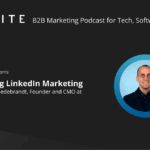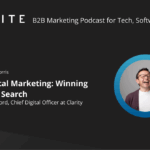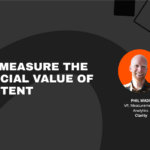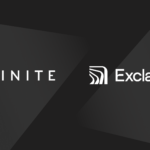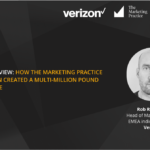Humanisation in B2B marketing almost feels like a buzzword.
But the sentiment behind it is growing increasingly important in a sea of B2B sameness fuelled by AI.
In this episode, learn what breaks through the slop, and what B2B customers now want to see from brands: Not just photos of your team on your ‘About Us’ page, but human soul, artistry, and love.
Hear from Deema Tamimi, VP Marketing at The Brief, who recently undertook a rebranding project that was fuelled with humanity.
Listen below, on Apple Podcasts or Spotify
Or watch on YouTube
And once you’re done listening, find more of our B2B marketing podcasts here!
The FINITE Podcast is sponsored by Clarity, a full-service digital marketing and communications agency. Through ideas, influence and impact, Clarity empowers visionary technology companies to change the world for the better.
Find the full transcript here:
We are humans, and there’s never been a time we’ve had to distinguish ourselves more, not from animals, but from ones and zeros.
Can you believe that? My guest today is Deema Tamimi, and we chat about the impact of human-centric marketing in a world full of AI, AI slop, agents, influencers, and even news presenters.
As Deema wisely says in this episode, it’s like the wild west out there. But we aim to shed a little more light on how to cut through in an AI era.
And from Deema’s perspective, that’s keeping humans front and center and not just putting pictures of your team on your about us page.
It’s about infusing a brand with that uniquely human sense of soul. You might finish this episode with more questions than answers, but that’s part of the fun.
Thanks so much for tuning in to another Finite Podcast episode. I truly hope you enjoy this one. Hi, Thank you for joining me on the Finite Podcast today.
Jodi, it’s great to be here. Thank you. It’s lovely to have you here. From our previous chats, I know that you have so many great insights, not just into B2B marketing channels or tactics, but kind of a great lens on the sector at large and how it’s evolved.
So I can’t wait for our audience to hear more about that. But before we do, as we always do, I will let you tell our audience a little bit more about yourself, your background in marketing, experience so far.
Yeah, I can see Poppy too. So, wow, I’ve been in marketing for a long time. I’m mostly in the tech sector, definitely dabbled in some non-tech stuff in the past.
And, you know, I have kind of an interesting background in that I started actually in the agency world.
I was actually a copywriter at an ad agency who was trying to get into more of sort of data driven marketing is what they called it back then.
So I have sort of that creative background working in in an agency and then really moving into sort of standard marketing for for technology companies.
And then really diving into growth. So growth was a, you know, there was a, there was a stage in marketing where, uh, if you could say that you were a growth hacker, it was very celebrated.
I went down that path and really built out my career in growth marketing and in growth product actually.
So very got, got into product as well. And now it’s interesting, um, because I’ve worked both on sort of the creative side and the brand side and also on the growth side.
Now I’m like leading marketing teams and bringing both of those things together. Um, and I’m now at the brief and I’ve been at the brief now for about six months and we just did a major launch and rebrand and, um, And we are working in the AI space, which seems almost impossible to not be working in the AI space these days.
And we are an AI agency for marketers. And it’s been a lot of fun. It’s been a lot of fun building up the team. It’s been a lot of fun launching a totally new brand and doing it in this time that is quite interesting.
We’re seeing a lot of very interesting things that I was doing back in the day coming back to being very important now in marketing and also just It’s a real learning time.
Like with this new AI world that we’re in, marketing is shifting and it’s happening so quickly. So it’s been a lot of fun, but it’s also been a bit of a crazy ride.
I’m sure you know that from people that you’re talking to in marketing all the time. Yeah, absolutely. Yeah, it’s so fun to get everyone’s different perspectives on it.
Yeah. And I’m sure we’ll get to hear more about the rebrand at The Brief and your team and how you run marketing there.
I’d love to dig into this a little bit further and just get your kind of perspective on how marketing has evolved and how you’re seeing things come full circle.
What’s been hot over the years and how has that changed, shifted in response to what we’re seeing now with AI?
Yeah, I keep saying it feels like it’s back to the future. It feels like we are, even though we are in this age of everything just rapidly changing things, marketers are having to sort of lean on some of the older things that we were doing in the past that became kind of, I guess, felt dated at the time.
And so it almost feels like the pendulum swinging a little bit. Like when I first started in marketing, it was a lot about brand and a lot about storytelling.
And then we went through this phase where it was all about the numbers and growth hacking and the mechanics and I think that became very overwhelming for marketers.
So this is actually nice that we’re starting to see a little bit of a shift. Many of us had to just sort of adapt and become really focused on growth marketing or growth hacking.
I definitely went down that path, as I noted. And in many ways, it was, you know, necessity. And, you know, many of us have kind of are able to do both that sort of like the quantitative part as well as that qualitative part.
but we had to lean really heavily into the quantitative and somewhat get away from the essence of marketing that we all kind of love and the reason why we came into it.
So one of the things we felt as we were like launching this new brand, The Brief, we really thought a lot about that essence of marketing and how can we, and how can into, by taking, by sort of offloading some of those mechanics that we don’t, most of us don’t love.
I’m sure there’s some people that love that space, but Most marketers go into marketing because of like the storytelling, the essence, the ideas, the creativity, not so much the like number crunching and the being in like 25 different tools to figure out what’s working and what’s not working.
And it did feel like, you know, I’d say like five years ago, it felt like we were at this like peak of burnout for marketers.
Just crazy. maybe even just two years ago, because AI is just going so fast right now. And now with AI, I think marketers are able to get back into a little bit more of the essence of marketing, the storytelling, the creativity.
And that’s actually super important because we’re seeing that our consumers and our customers are starting to not have as much trust in companies and kind of want to see something that feels real, something that feels like there’s a person behind it and so it’s this very interesting mix of ai enabling that in some ways, giving us more time to do that creativity.
And then we’re having to lean on things that, um, that help build trust because, and those are things like events, real, real life events, actually telling people about who’s behind the company.
That’s a new thing that like for a while, you know, a lot of companies had an about us page with the pictures of the people that started the company.
And then that kind of went out of fashion. It was like, who needs to know who those people are? And now it’s like, we’re starting, we have an about page with the people in the company that you might interface with or know because we want to make sure that people feel like we’re real.
So that it’s a very interesting thing where we’re using some of these older tactics in this new age to build trust.
Absolutely. Yeah. Yeah. I think that’s a great summary and a great kind of story to tell where marketers were forced to be an analytics department.
And then now we’re we’re getting back to that creativity. But I think there’s an interesting kind of pressure point or almost paradox here with AI.
And you mentioned this a little bit and it’s changing audience expectations. I want to dig into that a little bit more because we’re seeing narratives around AI slop and platforms like LinkedIn is filtering for AI and trying to find real human written content.
But then you’ve also got brands like Mercedes and Fintechs on TV when I’m watching Great British Bake Off.
They’re using AI to make full entire ads. You’ve got a Channel 4, this is very UK centric, but Channel 4 just had a entire presentation done by an AI agent in their, in the news segment to see if people would notice.
And so it’s this interesting kind of contradiction between Does the audience want AI or do they not?
Do you have any thoughts on that? I mean, I have thought a lot about that. actually very interested to see how this will evolve. And I think a lot of it will come down to what customers and consumers are willing to accept or like.
And I think what we’re seeing right now is we’re very much in an experimentation phase. People are all over the board. We’re already seeing brands saying not going to do that.
Like, and to differentiate themselves by saying we are not going to use AI and we’re going to be, you know, our differentiation is going to be like full authenticity.
And there is sort of a pushback from customers and consumers saying, you know, we don’t want to see that.
But then at the same time, you know, there’s a couple of things at play here. Like the brands that choose not to are going to potentially from an efficiency standpoint fall behind.
And then also I think it’s getting better and better. And I kind of wonder where consumers will fall. Like, I think it will also be interesting to see if we start to see some standards around that where consumers maybe are okay with it.
As long as they know that it’s AI generated, as long as there’s some type of like thing that notes it.
And I think there have been some studies done though, that today, if people see that, like, you know, if this has been generated by AI on an ad, doesn’t actually create more trust, which makes it then really hard for brands to do that because it’s easier to just use the AI and not say that if it doesn’t help build trust.
But I think it’s too early to say. I could see that becoming people seeing like, okay, well now all brands are doing this.
So at least this brand is saying that it is AI generated and maybe then it actually becomes like a trust signal.
But I will be… I think there’s going to be a world where it’s kind of a spectrum of authentic to AI generated.
And I think when it’s like fully AI generated and very, very little human co-creation, I think that’ll be kind of like a niche and it will be a look and people will like just be like, yep, that’s 100% AI.
And that’ll be kind of the brand feel of that brand who chooses to do that. But I think more people will be in this sort of co-creation place.
And I think we’re getting closer more and more brands are getting better about co-creating with AI to create something amazing, but that has a human essence, that has a human touch to it.
Absolutely. I think you’re right. We’re in this early stage experimentation phase, and it’s going to be interesting to see where it goes for sure.
But I wonder if that is also part of it. I wonder if these AI ads and this kind of AI agent narrative is propelled by the intrigue and the novelty of it and actually not knowing where it will go.
I wonder if we, when we kind of get used to it, when this is normalized as part of our everyday lives, that’s when human touch and creativity will really start to shine.
I think right now, I think you’re very right. Like there is a novelty to it right now. And there’s also kind of a like, let’s try this. Let’s try that. experimenting. And I don’t think people are landing yet on what’s going to resonate.
And I think the AI slop thing is definitely an issue and people are definitely now trying to move away from that in everything.
I mean, you see AI slop in terms of like people presenting documents. You’re like, wow, that was straight from an AI, you know, and like without any sort of like human touch to it later on.
And so I think we’ll start to see that. And I think start brands will start to find a place that, you know, once it becomes less of a novelty, they’ll start to find a place where it is this co-creation and they know how to work with AI.
I mean, it’s like anything like working with a team, you have to get used to that. And then you get into this place of comfort, and a place that’s more solid.
And I think we’re completely in non-solid ground right now. And brands are as well. Yeah, absolutely. So do you have any advice for B2B marketers in particular?
We are a B2B technology marketing podcast. B2B tech marketers using AI to create content. Do you have any kind of advice of how to fill that content with with kind of trust signals or add that human touch or do you have any kind of more practical, practical tips for b2b content?
Yeah, there’s a couple of things. I mean, I think there’s the part that i was mentioning before, which is like the co-creation.
Rather than sort of put in a prompt, get a thing and go forward with it. It’s about like almost um treating ai as your um as your co-creator as a as a partner getting something to, to where you want it to look and feel.
In terms of trust signals, there’s some really interesting things that we’re starting to find, which is like going back to the back to the future.
You know, getting covered by press is much more a thing, like in terms of like how are finding companies and having like more of that.
I mean, this is sort of the same as but like that authority. But we’re seeing more of that need. Um, and like things like the about page where people then like know who you are, because one of the things we’re seeing with, um, a lot of B2B companies and a lot of is that people are spinning up companies very quickly because they can’t because AI enables you to build a website, get something up there very quickly.
And then you’re wondering, is this thing going to be around? Like I just put my credit card in there. So my advice to, um, to companies, it is show who you are, like show who the actual people behind the company is because people are not trusting the fact that there are so many things spinning up and then disappearing or spinning up and are not trustworthy.
And it’s easy to be not trustworthy if you don’t show your face, if you don’t show that there’s a person behind, there’s a team behind this.
And so it’s kind of an old school way of doing things, but it does help people believe in you as something that’s going to be around forever.
long-term and believe in you for putting in their credit card and trusting you. So it’s what you’d expect. It’s like the word of mouth. It’s the being covered by press.
It’s being covered by legitimate people that other people trust. Again, it’s building all these trust signals in whatever ways you possibly can.
Absolutely. And honing in on LinkedIn as well, really building out real life, human-centered professional profiles for your employees and We’ve been talking about a lot of this stuff on the podcast recently.
I feel like with AI search in particular, there’s so many new angles to go with and to cover and to make sure that you’ve got this cohesive voice that something like AI search can pick up on.
We’re trying all sorts of things and tracking and trying to see, but consumer behavior is changing.
Whether people will trust the AI more than they trust their, you know, initial way of finding things, it’s an unknown.
And that’s why I think you have to try a lot. I think we’re in the phase of just like trying all the things and seeing, but, um, but one thing that we try to do is like sort of make that call, like, would this, is this potentially going to have a negative impact?
It may not have a positive, but would it have a negative? And, um, we think that right now sort of showing people, showing people who we are, um, behind the curtain is can help with the trusting of the software that we’re bringing forward and the AI solutions that we’re bringing forward.
And then that falls into things like you’re talking about on LinkedIn and videos with your face on it.
And we’re starting to see, I mean, this has already been a trend for a while, but it seems to be even more important now.
People want to see someone with a face, you know, not just a, you know, animated video of what, things do.
They want to see someone speaking and who knows where AI will go with that. And then it’s going to be, you know, like you said, on channel four, not a real person.
And that’s an interesting direction that things could go into. But right now, I think people are still sort of looking for real faces, telling them the benefits of a product and they want to see that.
I think that’s really good insight. And yeah, we can only work with what we know now. So I’d love to hear, I guess, more about Those concrete things that you know are working for The Brief.
You mentioned you just did a rebrand. Congratulations on that and a new website and everything. So you’ve made this About Us page. You’re putting humans front and center.
Is there anything else that you’ve noticed that has done really well with that rebrand? And also maybe a bit about the kind of process of that rebrand and did you kind of think about these things as part of that?
Yeah, yeah, that’ll be fun because we had a lot of fun. I mean, I think marketers love brand and love brand storytelling. And we, you know, we actually talked a lot about how what we were seeing in the market was a lot of AI brands not really doing a lot of brand storytelling, not really going through the exercise of like a true kind of deep dive into what their brand means and how they want to connect with their audience.
In one example, I took photos of a bunch of billboards on the 101 in San Francisco, which is where a lot of tech companies put up their big advertisements.
And so many of them said AI, you know, it’s like, that’s the thing, of course, all of them said AI.
And so many of them looked identical, like pretty, just like not that exciting, just without a lot of like human touch.
It felt very robotic in many ways, what we were seeing. And, you know, the ones who didn’t stood out. And that was interesting. That was an interesting insight. And we’re starting to hear this now.
And I’m glad that we sort of felt this. We felt that Mark, we’re our audience is marketers. So we’re an AI agency for marketers. And we, as marketers, many of us like came to it with like how we feel.
And we were feeling like, gosh, I just want to see like a really well-crafted, you know, well-crafted brand that has like a story behind it.
we, so we did a lot of like thinking through that, thinking about how our marketers feeling today. And we’re feeling burnt out, burnt out, wanting to get back to that essence.
We talked a lot about the golden age of advertising when marketing the mechanics were not such a big part of being a marketer.
You got sort of like sit. I mean, there were some bad things from the golden age of advertising, but in terms of the like essence of marketing and telling the story, they really, that’s what their focus was on.
Even were really into like the print, print, print and print media. And that timeframe, there was a lot of really amazing posters and awesome creative work being done by designers at that time that had this kind of warmth an organicness to it because it was in print.
And so that was inspiring for us. We took that in. And I think if you look at our brand, it really embraces sort of that human, that organic, but bringing it into this new age of AI.
So it’s not it’s not we didn’t want it to be dated. We didn’t want it to look like a kind of like a snapshot of time from in the past.
But we wanted to honor that and bring that into the future and really just have a very highly crafted brand.
brand, which was in itself felt like that’s something that marketers are wanting to see because they are our audience.
Something that’s differentiated from like kind of what we’re seeing, which is like cut and paste. What I was seeing on the 101, which was very much these almost no brand brands and really no feel of connection to craft.
And so that was a lot of fun. It was quite a fun process. And then launching it was a big feat. We had, I think anybody who’s been through a rebrand knows that it’s very, very difficult.
And we made a maybe tough decision, I guess, or we made a decision that we would do it along with going out with new product offering, new pricing and packaging, entirely new website, obviously.
And so it was a lot. to do it once, but we’ve been really pleased with, you know, how it all came out. And we’re really excited to be able to, along with bringing out a new brand, it’s sort of meant to also match the aspirations that we have for the product, which is that it’s the full marketing flywheel.
Before we were really, really focused on the create portion of the marketing flywheel. And now it’s everything from, you know, the discovery and mood boarding all the way through from create into the space of learning and optimizing and having AI help you along that entire flywheel.
I think that story of where you got your inspiration is almost really inspiring in itself, mostly because it sounds like what you really wanted to get back to was like pure artistry.
And with that artistry comes like this almost peak art. peeking into someone’s soul like the soulfulness and that is almost the opposite of ai i know she does not have a soul is not human is this it is a robot is it is a model it’s numbers and ones and zeros so it’s almost like you you are really trying to reinvigorate that that piece of that piece of human humanity, that soul into, into the brand.
Is that kind of, don’t you agree with that? You captured it better than I did. Yes, that’s a, that’s exactly what we were trying to do. And it’s because, like I mentioned, that our, our audience is marketers and marketers are, are feeling very, very burnt out, burnt out in like constantly sitting in Tools.
I mean, just that alone, a number of tools that marketers have to use across that flywheel and like, and then new tools are constantly popping up and it starts to make you, one of the sort of themes that we had as we were thinking about is we’re starting to feel like we’re being made into machines and we’re not machines and we don’t want to be machines and we want to go back to the creativity.
That’s why we got into marketing and into the strategy. And instead we’re literally sitting in know a thousand tabs trying to just like make sense of what’s working and what’s not working.
And so we wanted to connect on that level of of humanness and that is that we don’t, we believe that it is, it is co-creation with AI, um, is meant to, and how we harness it and help people use ai is meant to sort of take the mechanical part away.
but not take the human part away. The human part is the partner to that. And so we wanted that to show up in the brand. We wanted to connect on that human part and the part that people want to continue to be able to bring into marketing.
And what we’re doing is helping you do that, but not have to do the mechanical part. Yeah, so you captured it beautifully. It really was a very, very intentional thing for this to feel human, to feel a little bit organic, and to have a little bit of a callback to this age when we weren’t so underneath so many tabs and tools and the mechanics of marketing that happened in this sort of growth marketing, growth hacking era.
I think it’s really interesting as well, because as you’ll know, with doing rebrands, the brand producers, the designers, they draw on kind of research from the sector, what’s working, what signals like authority or signals kind of resonance or familiarity within certain sectors.
And so we’ve kind of created this really cannibalized marketing formula where everything’s so kind of mathematical and written down like by the book.
But it sounds like what you’re saying is that we need to listen to this calling to just like absolutely puncture that and create things that come from the humans behind the brand and what that brand is trying to say and how it’s trying to stand out.
Because it’s not just AI that’s brought us to this very kind of cookie cutter place. It’s almost like you say, this growth hacking era where it was all kind of everything so measured and technical.
Yeah. Well, we’ve optimized ourselves prior to AI. We were optimizing ourselves into like, I mean, it’s no surprise that like everyone, it looks all the same because like I’m sure the numbers might say that.
But if you want to be a brand that stands out and a brand that people remember and a brand that people trust in our long term, and we know some of those brands in the world, right?
They aren’t doing it that way. They are sitting there and doing a lot of like human concepting and thinking through the essence and how they’re connecting with their customers.
And in many ways, AI now makes that possible for more companies to do that because some of those brands, those really big ones, have giant, giant budgets.
And so they can do that. And now I think this actually makes it possible for more marketers to be able to bring that creativity and then have and help them with the things that actually cost a lot of money, but are also not the part that we all got into marketing for.
We don’t particularly love that. the mechanics of it. So yeah, I think you got that right. Cool. I think that’s a really optimistic and positive and hopeful and energizing note to end on, where we can take that into our marketing, see AI as a tool, not a replacement, and really infuse that humanity into it, which I think we’ve even done from this conversation.
We’ve really just laid it all out on the table. So thank you so much. for doing that with me, Deema. It’s been an absolute pleasure. Thank you. It’s been a pleasure for me too as well.
Thanks so much for having me.



